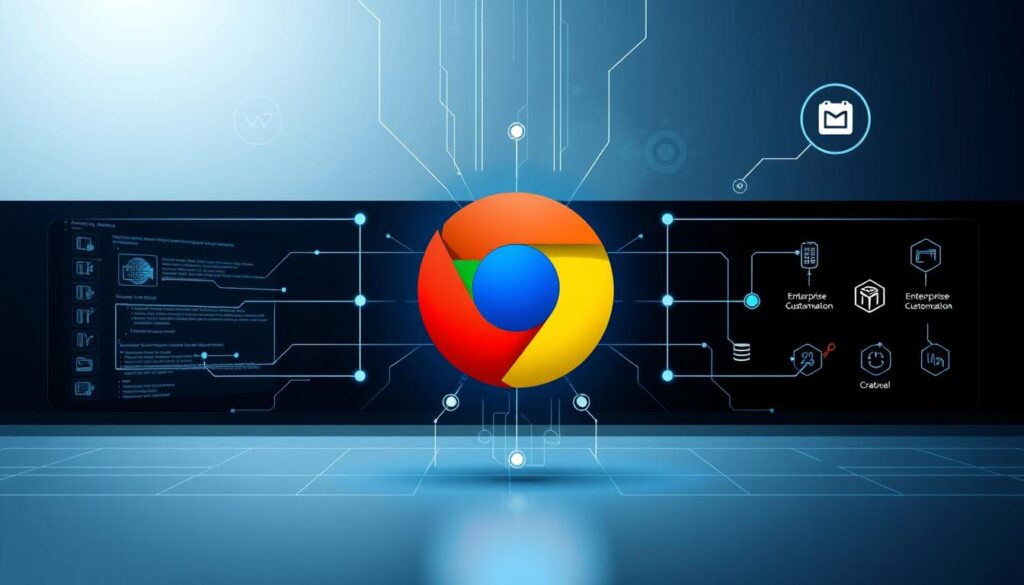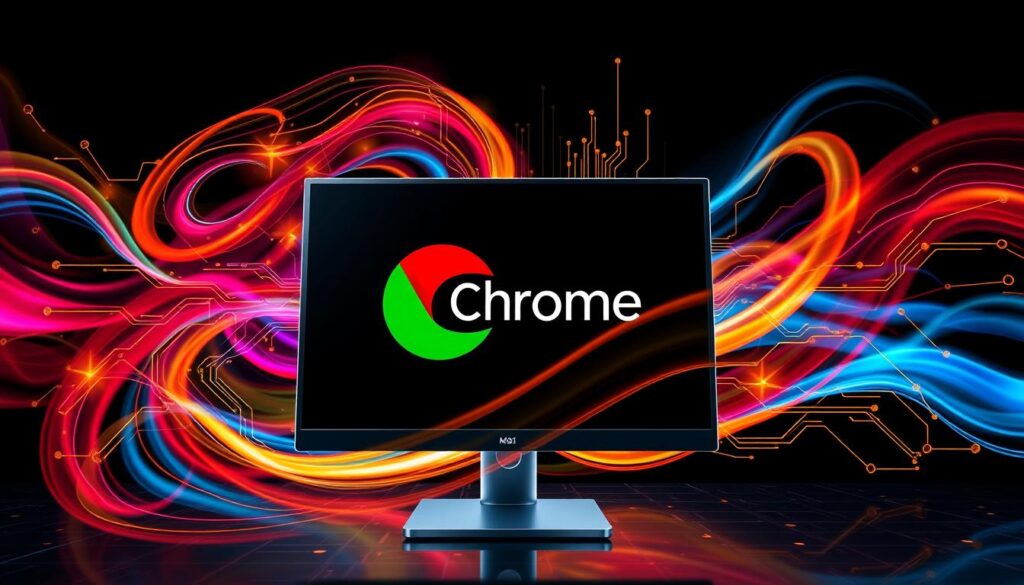Companies of all sizes and places use Chrome Enterprise every day. They need to keep Google’s chrome browser installer updated. There are over 400 msi package chrome policies to customize Chrome for your business.
Stay current with the newest releases from Chrome Enterprise and ChromeOS.
Key Takeaways
- Over 400 policies are available to customize Google Chrome to fit specific business needs.
- Companies of all sizes and locations rely on Chrome Enterprise daily.
- Technical documentation is available for keeping the chrome offline installer up to date across various operating systems.
- Policies can be set to determine which URLs open in an alternative browser.
- Chrome can be configured to report security events across browser fleets.
Deploying and Managing Chrome Enterprise Across Windows Devices
As a Microsoft Windows administrator, you can use Chrome Enterprise to make Google Chrome easier to manage. The Chrome Enterprise MSI package helps you set up and keep Chrome running on many devices at once. This makes it simple to manage Chrome for your whole team.
Accessing Technical Documentation for Chrome Windows Deployment
Google has detailed guides to help you set up Chrome Enterprise on Windows. These guides cover how to get the MSI package ready, set up Chrome policies, and connect it with your IT systems. With these tips, you can make Chrome deployment smooth and fit your company’s needs.
Setting Chrome as the Default Browser in Windows Environments
The Chrome Enterprise MSI package lets you make Google Chrome the default browser for your Windows company. This makes sure everyone uses Chrome the same way, without having to change settings on each computer. You can also control Chrome settings from one place, keeping your company’s web experience consistent.
| Chrome Enterprise Deployment Metrics | Value |
|---|---|
| Minimum OS version required | Windows 10 version 1607 or later |
| Maximum application size per app | 30 GB |
| Eligible device categories | Azure AD registered, Azure AD joined, or Hybrid Azure AD joined |
| Steps to prepare Win32 app content for Intune | 5 steps |
| Size of Google Chrome installer (.msi) | 116,199,201 bytes |
| Example Install command | msiexec /i “GoogleChrome.msi” /qn |
| Log file location (post-Intune app installation) | C:ProgramDataMicrosoftIntuneManagementExtensionLogsIntuneManagementExtension.log |
By using the Chrome Enterprise MSI and Google’s guides, Windows admins can make Chrome easy to deploy and manage. This ensures a safe and consistent web experience for everyone in your company.
Strategies for Keeping Chrome Up-to-Date on Windows
Keeping your chrome msi bundle updated on Windows is key for top performance and security. It also lets you use the newest features. There are smart ways to make the chrome network deployment and chrome silent install easier.
Exploring Options for Updating Chrome in Windows
Using Microsoft’s Endpoint Manager and Settings Catalog is a great idea. It lets you manage Chrome updates and set policies from one place.
Microsoft Intune Import Administrative templates are another good choice. They let you customize Chrome policies to fit your business needs.
- Scheduled reboots help Chrome updates go smoothly, as Giridhara (Zoho) and Alex Fogerty say.
- Tools like PDQ Inventory/Deploy, suggested by Big Green Man, make updating software easier.
- Using the chrome msi bundle instead of user-installed versions, as Bryan Doe advises, gives better control.
- Chocolatey, as mentioned by MarkH3326, helps automate updates in your Windows environment.
By trying out these strategies and using the right tools, you can keep your chrome network deployment up-to-date. This ensures a smooth experience for everyone.

Configuring Chrome Policies for Windows Environments
Google Chrome is a top choice for businesses. It has over 400 policies for managing Windows devices. This lets companies customize Chrome to meet their needs, keeping users productive and safe.
Setting Policies to Determine Alternative Browser Usage
Chrome lets you decide when to use other browsers. This is key for apps that need Internet Explorer. The Legacy Browser Support (LBS) feature makes it easy to use older web experiences in Chrome.
IT teams can use Windows Group Policy or tools like MDM for Mac. They can also use JSON files. This makes it easy to set up Chrome in a way that fits their systems.
| Policy Setting | Description | Impact |
|---|---|---|
| LegacyBrowserSupportEnabled | Enables Legacy Browser Support for older websites and apps. | Makes sure Chrome works with old web content on Windows devices. |
| LegacyBrowserList | Lists URLs to open in a legacy browser like Internet Explorer. | Helps IT teams choose which sites to open in an alternative browser, making things smooth for users. |
| AutoOpenLegacyBrowserForUrls | Opens legacy browsers for certain URLs based on LegacyBrowserList. | Makes things easier for users by automatically choosing the right browser, saving time. |
With these policies, IT teams can make sure Chrome works well on Windows. It’s secure and fits the company’s needs, including working with old web content.
Google Chrome MSI: Enabling Enterprise-Grade Customization
Businesses and organizations can use the Chrome MSI to manage Google Chrome on Windows. It lets IT admins customize the browser for their needs. This includes the Legacy Browser Support (LBS) MSI for extra features.
The “distribution” object in the master_preferences file controls Chrome’s setup. You can set “auto_launch_chrome,” “disable_logging,” and “make_chrome_default” to change how Chrome works. There are also settings for user profiles, like “safebrowsing.enabled” and “search.suggest_enabled.”
| Setting Type | Example Settings | Description |
|---|---|---|
| Distribution Settings | auto_launch_chrome disable_logging make_chrome_default | Configurations applied during the Chrome installation process |
| Non-Distribution Settings | safebrowsing.enabled search.suggest_enabled import_saved_passwords | Preferences applied to user profiles |
These settings can be set as true or false, numbers, or text. This lets admins turn on features, set defaults, and control imports. It’s key for companies to make Chrome fit their needs for a safe and productive web experience.

With the chrome browser installer and msi package chrome, companies can use the chrome offline installer. This makes it easy to set up and manage Google Chrome across Windows environments.
Managing Chrome Extensions and Security Reporting
More companies are using chrome enterprise deployment and chrome bulk deployment. This makes managing browser extensions on Windows devices very important. It helps keep work productive and safe from security threats.
Maintaining Extension Oversight Across Windows Browsers
Chrome’s cloud tool helps IT admins control extensions on Windows. This lets companies:
- Stop non-compliant extensions that could harm security or work
- Manage and update approved extensions easily
- Watch for any misuse or security issues
- Make sure only safe extensions are installed
Configuring Chrome Security Event Reporting
Companies need to set up Chrome’s security event reporting. This helps spot threats and data breaches. By doing this, they can:
- See security events like malware and phishing in real time
- Keep a detailed record for compliance and to handle incidents
- Use the data to make security policies better
- Connect the security data with SIEM systems for better monitoring
Managing extensions and security reporting are key to a strong chrome enterprise deployment. By focusing on these, companies can keep their Chrome on Windows safe, productive, and in line with rules.
Deploying and Managing Chrome on Mac Devices
Managing browsers for big companies can be hard. But Google Chrome has made it easier for Mac devices. Now, businesses can use Mobile Device Management (MDM) tools to create custom Chrome packages. This makes it easy to use Chrome on all Macs.
Creating Custom Installation Packages with MDM Tools
Chrome lets you make the browser fit your company’s needs. IT teams can use MDM tools to make special Chrome packages. These packages have settings, policies, and extensions already set up.
This way, teams can make sure everyone uses the same browser. It helps them work better and stay safe. And it’s all managed from one place.
Google Chrome Enterprise makes setting up Chrome easy. It has lots of help and clear steps. So, IT teams can set up Chrome on Macs without worry.
| Feature | Benefit |
|---|---|
| Custom Chrome Installation Packages | Tailor the browser to your organization’s unique needs, streamlining deployment and enhancing user experience. |
| Centralized Policy Management | Enforce consistent browser settings, security controls, and productivity-enhancing features across your Mac fleet. |
| Seamless Integration with MDM Tools | Leverage your existing mobile device management infrastructure to deploy and manage Chrome on Mac devices. |
Using chrome enterprise deployment and Google Chrome’s customization helps a lot. It makes sure Mac users have a good, safe browser. With the right tools, IT teams can manage Chrome on all kinds of devices.
Conclusion
Businesses of all sizes use Google Chrome Enterprise every day. They explore technical documents and resources to get the most out of Chrome. This is true whether they use it on Windows, Mac, or other devices.
They keep up with the newest google chrome msi releases and customization options. This makes sure their chrome browser installer deployment fits their needs.
Chrome Enterprise has everything from the msi package chrome to the chrome offline installer. It offers tools for easy chrome enterprise deployment. With chrome customized installation and chrome silent install, deploying Chrome becomes smooth.
By knowing the latest about the chrome msi bundle, you can use Chrome to its fullest. This is true for Windows, Mac, or any device. With the right plans and tools, your Chrome deployment will meet your business goals and user needs.
Frequently Asked Questions
Kuldeep Nirgude is a computer science student with a strong interest in finance and marketing. With a focus on analyzing industry trends, he writes articles that simplify complex concepts and empower readers to make informed decisions. Kuldeep is dedicated to bridging the gap between technology and business, and is committed to staying updated on the latest innovations shaping the economy.
